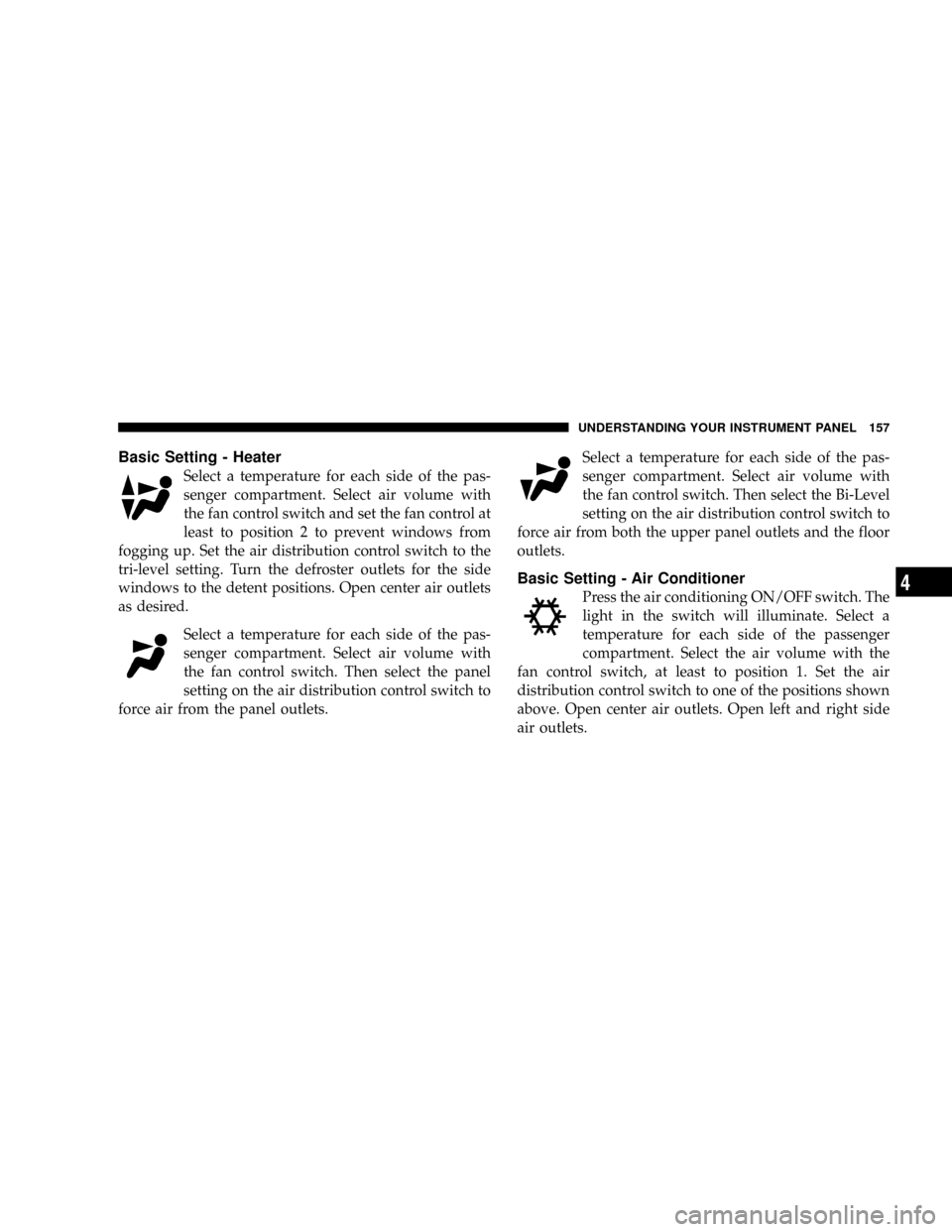Page 128 of 358
NFan Control.........................156
NBasic Setting - Heater..................157
NBasic Setting - Air Conditioner............157NDust Filter (If Equipped)................162
NOperating Tips.......................163
126 UNDERSTANDING YOUR INSTRUMENT PANEL
Page 159 of 358

Basic Setting - Heater
Select a temperature for each side of the pas-
senger compartment. Select air volume with
the fan control switch and set the fan control at
least to position 2 to prevent windows from
fogging up. Set the air distribution control switch to the
tri-level setting. Turn the defroster outlets for the side
windows to the detent positions. Open center air outlets
as desired.
Select a temperature for each side of the pas-
senger compartment. Select air volume with
the fan control switch. Then select the panel
setting on the air distribution control switch to
force air from the panel outlets.Select a temperature for each side of the pas-
senger compartment. Select air volume with
the fan control switch. Then select the Bi-Level
setting on the air distribution control switch to
force air from both the upper panel outlets and the floor
outlets.
Basic Setting - Air Conditioner
Press the air conditioning ON/OFF switch. The
light in the switch will illuminate. Select a
temperature for each side of the passenger
compartment. Select the air volume with the
fan control switch, at least to position 1. Set the air
distribution control switch to one of the positions shown
above. Open center air outlets. Open left and right side
air outlets.
UNDERSTANDING YOUR INSTRUMENT PANEL 157
4
Page 171 of 358
NOTE:Due to the starter non-repeat feature, the key
must be turned completely to the left before attempting
to start the engine again.Extremely Cold Weather (below -20ÉF or -29ÉC)
For reliable starting in areas where temperatures fre-
quently drop below -20ÉF (-29ÉC), we recommend the use
of an externally powered battery and an electric engine
block heater. Advice on these items and installation is
available at your authorized dealer.
If Engine Fails to Start
CAUTION!
Do not try to push or tow your vehicle to get it
started. Your vehicle cannot be started this way.
Pushing with another vehicle may damage the trans-
mission or the rear of your vehicle. See Section 6 of
this manual for proper jump-starting procedures.
STARTING AND OPERATING 169
5
Page 235 of 358

In any of the following situations, you can reduce the
potential for overheating by taking the appropriate ac-
tion.
²On the highways ±Slow down and use the highest
gear possible.
²In city traffic ±While stopped, put the transmission in
NEUTRAL, but do not increase engine idle speed.
²In city traffic ±While moving, shift into the highest
gear possible to reduce engine RPM.
NOTE:There are steps that you can take to slow down
an impending overheat condition. If your air conditioner
is on, turn it off. The air conditioning system adds heat to
the cooling system and turning off the A/C removes this
heat. You can also turn the temperature control to maxi-
mum heat, the mode control to floor, and the fan controlto HIGH. This allows the heater core to act as a supple-
ment to the radiator and aids in removing heat from the
cooling system.
CAUTION!
Driving with a hot cooling system could damage
your vehicle. If temperature gauge reads ªH,º pull
over and stop the vehicle. Idle the vehicle with the air
conditioner turned OFF until the pointer drops back
into the normal range. If the pointer remains on the
ªH,º turn the engine OFF immediately, and call for
service.
WHAT TO DO IN EMERGENCIES 233
6
Page 245 of 358
1. Wear eye protection and remove any metal jewelry
such as watch bands or bracelets that might make an
inadvertent electrical contact.
2. When boost is provided by a battery in another
vehicle, park that vehicle within booster cable reach butwithout letting the vehicles touch. Set the parking brake,
place the transmission in NEUTRAL and turn the igni-
tion OFF for both vehicles.
3. Turn off the heater, radio and all unnecessary electrical
loads.
WHAT TO DO IN EMERGENCIES 243
6
Page 301 of 358
Underhood Accessory Fuse Block Fuses
Cavity Fuse Circuits
1 5 Amp
BeigeGarage Door Opening Signal,
Tire Pressure Control and Seat
Heater
2 5 Amp
BeigeControl Unit Airbag
3 5 Amp
BeigeIndicator, Safety Restraint System
and Indicator Passenger Airbag
Off
4 7.5 Amp
BrownHeated Mirror
5 15 Amp
BlueRadio (Coupe)
5 25 Amp
WhiteRoof Control Module (Roadster)
6 5 Amp
BeigeExterior Mirror Adjustment, Left
And Right (Coupe)
MAINTAINING YOUR VEHICLE 299
7
Page 302 of 358
Cavity Fuse Circuits
6 40 Amp
OrangeRoof Hydraulic Unit (Roadster)
7 5 Amp
BeigeOccupation Classification Module
(Right Seat)
8 15 Amp
BlueRadio
9 5 Amp
BeigeControl Unit Airbag
10 5 Amp
BeigeSpeed Control
11 15 Amp
BlueIgnition Coil 6 Cyl.
12 10 Amp
RedWasher Liquid Heater, Washer
Nozzle Heater
13 10 Amp
RedRoof Light, Horn, Anti-Theft-
Alarm, Trunk Light and Tire
Pressure ControlCavity Fuse Circuits
14 10 Amp
RedDiagnostic Socket
15 5 Amp
BeigeClimate Control, Auxiliary Water
Pump
16 10 Amp
RedSpoiler Motor
17 40 Amp
OrangeElectronic Stability Program
18 40 Amp
OrangeElectronic Stability Program
19 40 Amp
OrangePower Window, Front
20 30 Amp
GreenWiper Motor
21 30 Amp
GreenSeat Adjustment Right Side
22 30 Amp
GreenSeat Adjustment Left Side
300 MAINTAINING YOUR VEHICLE
Page 303 of 358
Cavity Fuse Circuits
23 15 Amp
BlueSound Booster (Amplifier)
24 30 Amp
GreenSeat Heater
25 20 Amp
YellowPneumatic Control Unit, Rear
Window Defroster
26 20 Amp
YellowCentral Locking
30 Spare (Coupe)
30 15 Amp
BlueRadio (Roadster)
31 15 Amp
BlueCigar Lighter, Glove Compart-
ment Light
32 15 Amp
BlueWiper, Washer Pump, Headlight
Flasher
33 5 Amp
BeigeControl UnitCavity Fuse Circuits
34 Spare (Coupe)
34 30 Amp
GreenClimate Control (Roadster)
35 15 Amp
BlueRadio Frequency Remote Control,
Hazard Warning Flasher, Instru-
ment Cluster, Climate Control
36 30 Amp
GreenClimate Control (Coupe)
36 5 Amp
BeigeExterior Mirror Adjustment
(Roadster)
37 7.5 Amp
BrownCirculating Air, Instrument Clus-
ter, Radio Frequency Remote
Control, Climate Control, Central
Control Unit
MAINTAINING YOUR VEHICLE 301
7